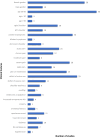Clinical features in rotator cuff calcific tendinopathy: A scoping review
- PMID: 39552687
- PMCID: PMC11562322
- DOI: 10.1177/17585732241244515
Clinical features in rotator cuff calcific tendinopathy: A scoping review
Abstract
Introduction: The main goal of this scoping review is to highlight the clinical features of subjects with rotator cuff calcific tendinopathy (RCCT), in order to identify and map this condition clinical criteria, and thus to be able to hypothesize such pathology before imaging investigations.
Methods: Four databases were consulted up to January 2023. The obtained results were reported following the PRISMA-ScR and the Joanna Briggs Institute reviewer's manual was used as guideline for conducting the review. No time and geographical restrictions were applied.
Results: A total of 851 records have been identified, with 50 studies meeting the inclusion criteria. Subjects with RCCT mostly reported nightly, acute and severe pain with spontaneous onset. Symptoms were mostly unilateral. Subjects were mostly women aged between 30 and 60. Deficit in active and passive range of motion was reported, mainly during abduction and forward flexion. Endocrine and metabolic disorders were described as comorbidity, in particular diabetes and thyroid disorders.
Conclusion: In this scoping review, the most relevant RCCT clinical features were detected. These clinical criteria, predictive for shoulder RCCT, can be crucial to help all clinicians suspect this musculoskeletal disease early and with certainty, thus allowing for an appropriate and prompt diagnosis path.
Level of evidence: III.
Keywords: calcific tendinopathy; clinical features; scoping review; shoulder.
© The Author(s) 2024.
Conflict of interest statement
The authors declared no potential conflicts of interest with respect to the research, authorship, and/or publication of this article.
Figures
Similar articles
-
Effectiveness of non-surgical management in rotator cuff calcific tendinopathy (the effect trial): protocol for a randomised clinical trial.BMJ Open. 2024 Jan 4;14(1):e074949. doi: 10.1136/bmjopen-2023-074949. BMJ Open. 2024. PMID: 38176875 Free PMC article.
-
Imaging of calcific tendinopathy around the shoulder: usual and unusual presentations and common pitfalls.Radiol Med. 2021 Apr;126(4):608-619. doi: 10.1007/s11547-020-01300-0. Epub 2020 Nov 5. Radiol Med. 2021. PMID: 33151457 Free PMC article. Review.
-
Zero echo time MRI in shoulder MRI protocols for the diagnosis of rotator cuff calcific tendinopathy improves identification of calcific deposits compared to conventional MR sequences but remains sub-optimal compared to radiographs.Eur Radiol. 2023 Sep;33(9):6381-6391. doi: 10.1007/s00330-023-09602-3. Epub 2023 Apr 4. Eur Radiol. 2023. PMID: 37014406
-
Risk Factor Analysis for Predicting the Onset of Rotator Cuff Calcific Tendinitis Based on Artificial Intelligence.Comput Intell Neurosci. 2022 Apr 11;2022:8978878. doi: 10.1155/2022/8978878. eCollection 2022. Comput Intell Neurosci. 2022. Retraction in: Comput Intell Neurosci. 2023 Nov 29;2023:9847082. doi: 10.1155/2023/9847082. PMID: 35449743 Free PMC article. Retracted.
-
Rotator cuff calcific tendinopathy: from diagnosis to treatment.Acta Biomed. 2018 Jan 19;89(1-S):186-196. doi: 10.23750/abm.v89i1-S.7022. Acta Biomed. 2018. PMID: 29350647 Free PMC article. Review.
References
-
- Robinson DM, Schowalter S, McInnis KC. Update on evaluation and management of calcific tendinopathy. Curr Med Phys Rehabil Rep 2021; 9: 57–69.
-
- Greis AC, Derrington SM, McAuliffe M. Evaluation and nonsurgical management of rotator cuff calcific tendinopathy. Orthop Clin North Am 2015; 46: 293–302. - PubMed
Publication types
LinkOut - more resources
Full Text Sources
Research Materials


